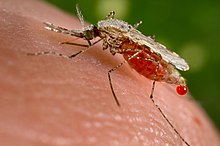| Anopheles stephensi | |
|---|---|

| |
| Scientific classification | |
| Domain: | Eukaryota |
| Kingdom: | Animalia |
| Phylum: | Arthropoda |
| Class: | Insecta |
| Order: | Diptera |
| Family: | Culicidae |
| Genus: | Anopheles |
| Subgenus: | Cellia |
| Species: | A. stephensi
|
| Binomial name | |
| Anopheles stephensi Liston, 1901
| |
Anopheles stephensi is a primary mosquito vector of malaria in urban India and is included in the same subgenus as Anopheles gambiae, the primary malaria vector in Africa.[1] A. gambiae consists of a complex of morphologically identical species of mosquitoes, along with all other major malaria vectors; however, A. stephensi has not yet been included in any of these complexes.[2] Nevertheless, two races of A. stephensi exist based on differences in egg dimensions and the number of ridges on the eggs; A. s. stephensi sensu stricto, the type form, is a competent malaria vector that is found in urban areas, and A. s. mysorensis, the variety form, exists in rural areas and exhibits considerable zoophilic behaviour, making it a poor malaria vector.[3] However, A. s. mysorensis is a detrimental vector in Iran.[4] An intermediate form also exists in rural communities and peri-urban areas, though its vector status is unknown.[4] About 12% of malaria cases in India are due to A. stephensi.[5]
In November 2015, an American research group demonstrated that an A. stephensi with genetic modifications could be rendered incapable of transmitting malaria, and that 99.5% of the mutant mosquitoes' offspring were also immune.[6]
In April of 2023, a malaria outbreak at Dire Dawa University in Ethiopia affected 1,300 students. The outbreak was a mystery because it occurred in the dry season and in an urban area, both atypical conditions for common cases of malaria in this area of the world. Blood tests confirming malaria's ring-shaped parasite ultimately led researchers to conclude that it was the work of A. stephensi, which thrives in urban areas and dry seasons, and has a resistance to insecticides.[7]
A team of scientists, headed by an entomologist from the University of Oxford, conducted an evaluation of Africa's environments to determine if they provide suitable conditions for the A. stephensi mosquito. Their findings indicate that the ongoing spread of this species could potentially expose an additional 126 million persons to the risk of malaria.[7]
- ^ Valenzuela, Jesus G.; Francischetti, Ivo M.B.; Pham, Van My; Garfield, Mark K.; Ribeiro, José M.C. (2003). "Exploring the salivary gland transcriptome and proteome of the Anopheles stephensi mosquito". Insect Biochemistry and Molecular Biology. 33 (7). Elsevier: 717–732. doi:10.1016/s0965-1748(03)00067-5. ISSN 0965-1748. PMID 12826099.
- ^ Dash, A. P.; Adak, T.; Raghavendra, K.; Singh, O. P. (2007). "The biology and control of malaria vectors in India". Current Science. 92 (11). Current Science Association + Indian Academy of Sciences: 1571–1578. ISSN 0011-3891. JSTOR 24097721.
- ^ Malhotra, Prithvi Raj; Jatav, Prakash Chandra; Chauhan, Ram Singh (2000). "Surface morphology of the egg of anopheles stephensi stephensi sensu stricto (diptera, culicidae)". Italian Journal of Zoology. 67 (2). Taylor & Francis: 147–151. doi:10.1080/11250000009356307. ISSN 1125-0003.
- ^ a b Sinka, M.E., Bangs, M.J., Manguin, S., Chareonviriyaphap, T., Patil, A.P., Temperley, W.H., Gething, P. W., Elyazar, I.R.F., Kabaria, C.W., Harbach, R.E., & Hay, S.I. (2011). The dominant Anopheles vectors of human malaria in the Asia-Pacific region: occurrence data, distribution maps and bionomic précis. Parasites & Vectors, 4, 1-46.
- ^ Tikar, S. N.; Mendki, M.J.; Sharma, A. K.; Sukumaran, D.; Veer, Vijay; Prakash, Shri; Parashar, B. D. (2011). "Resistance Status of the Malaria Vector Mosquitoes, Anopheles stephensi and Anopheles subpictus Towards Adulticides and Larvicides in Arid and Semi-Arid Areas of India". Journal of Insect Science. 11 (85). Entomological Society of America (OUP): 1–10. doi:10.1673/031.011.8501. ISSN 1536-2442. PMC 3281435. PMID 21870971.
- ^ Gemuteerde mug moet malaria bestrijden Nederlandse Omroep Stichting 24 November 2015 (in Dutch)
- ^ a b Nolen, Stephanie; Negeri, Tiksa (29 September 2023). "An Invasive Mosquito Threatens Catastrophe in Africa". The New York Times. Retrieved 18 February 2024.